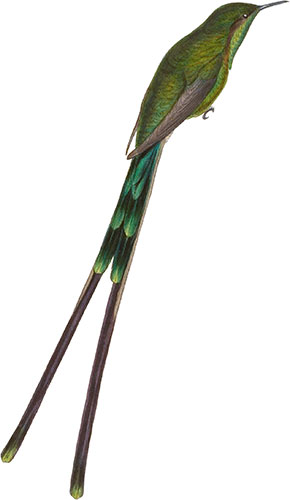Perhaps the next in affinity, although not directly allied, are the members of the genus Lesbia, which are equally confined to the Andes, and fly at the same elevation as the Spathuræ. Like those birds, they are distributed along that great chain of mountains, throughout many degrees of latitude on each side of the equator. They may be regarded as among the most elegant of the Trochilidæ. Their long and deeply cleft tails would seem to indicate that they possess very great powers of aërial progression,—a remark which equally applies to the members of the genera Cynanthus and Cometes.
Lesbia Gouldi
Habitat: The high lands of New Granada, particularly the neighbourhood of Bogota
 Plate 167
Lesbia Gouldi
Bogota Train-bearer
Plate 167
Lesbia Gouldi
Bogota Train-bearer
Lesbia Nuna
Habitat: Peru
 Plate 169
Lesbia Nuna
Nouna-Koali
Plate 169
Lesbia Nuna
Nouna-Koali
Refer to my remarks respecting this bird in the letter-press accompanying the Plate.
Lesbia Amaryllis
Habitat: New Granada, Ecuador, and Peru
 Plate 170
Lesbia Amaryllis
Train-bearer
Plate 170
Lesbia Amaryllis
Train-bearer
Dark or nearly black varieties not unfrequently occur among the Trochilidæ; and I think that the bird to which M. Bourcier has given the name of Victoriæ is merely such a variety of the L. Amaryllis.
Lesbia eucharis
Habitat: New Granada
 Plate 171
Lesbia eucharis
Train-bearer
Plate 171
Lesbia eucharis
Train-bearer
Considerable, and I fear inextricable, confusion exists with regard to the genera Lesbia and Cynanthus, which would appear to be due to the various authors who have used those terms taking their characters from defective descriptions or imperfect drawings, instead of actual specimens. This confusion I have endeavoured to rectify by applying the terms to the birds which I believe their respective proposers actually intended, and I do hope that, for the sake of science, they will be allowed so to stand for the future.
Featuring all 422 illustrated species from John Gould’s A Monograph of the Trochilidæ, or Family of Humming-Birds arranged by color.